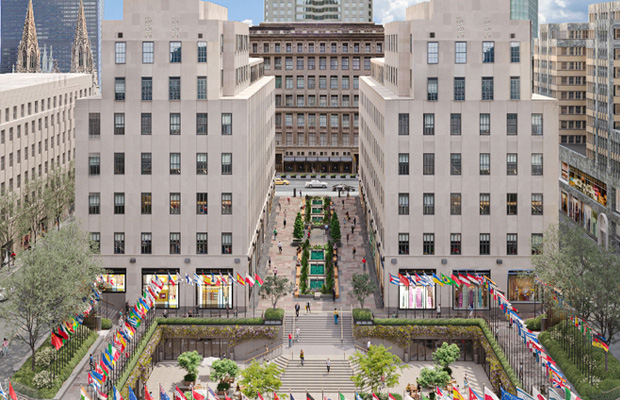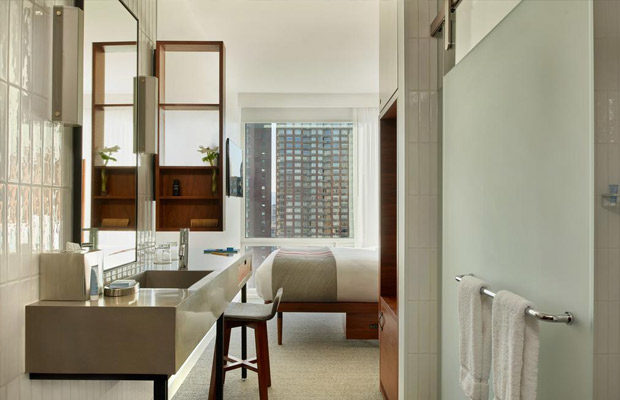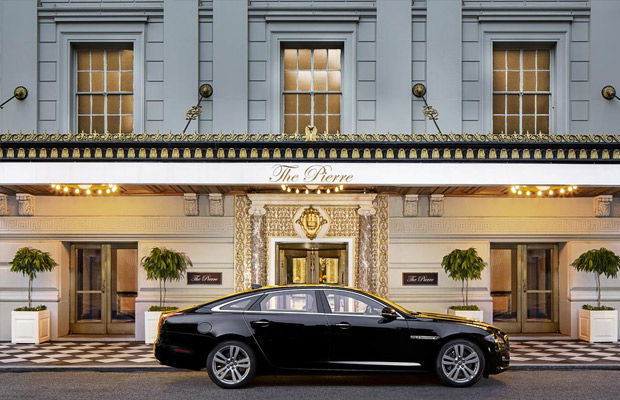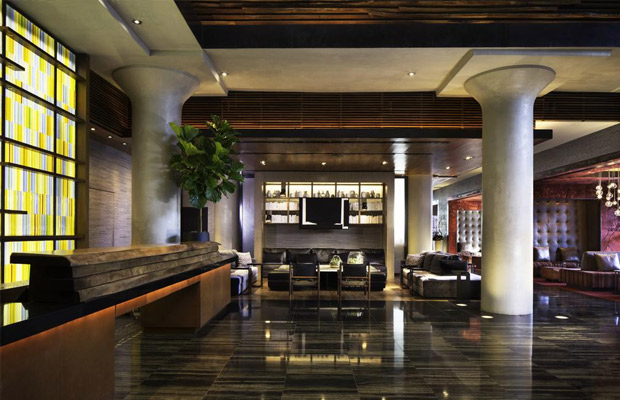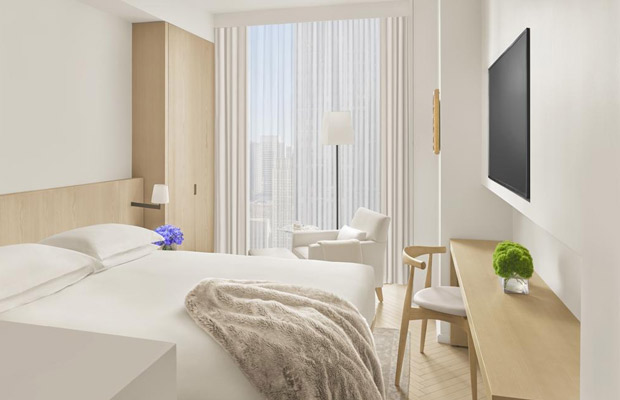Times Square
Times Square
USA
New York
New York Travel Guide
Book Tour & Activities
Your tour in New York.
Book your stay
Your hotel in New York.
Overview
Times Square is a major commercial intersection, tourist destination, entertainment center, and neighborhood in the Midtown Manhattan section of New York City, at the junction of Broadway and Seventh Avenue. Brightly lit by numerous billboards and advertisements, it stretches from West 42nd to West 47th Streets, and is sometimes referred to as "the Crossroads of the World", "the Center of the Universe", "the heart of the Great White Way", and "the heart of the world". One of the world's busiest pedestrian areas, it is also the hub of the Broadway Theater District and a major center of the world's entertainment industry.
Times Square is one of the world's most visited tourist attractions, drawing an estimated 50 million visitors annually. Approximately 330,000 people pass through Times Square daily, many of them tourists, while over 460,000 pedestrians walk through Times Square on its busiest days. Formerly known as Longacre Square, Times Square was renamed in 1904 after The New York Times moved its headquarters to the then newly erected Times Building, now One Times Square.
History
Early history
When Manhattan Island was first settled by the Dutch, three small streams united near what is now 10th Avenue and 40th Street. These three streams formed the "Great Kill" (Dutch: Grote Kil). From there the Great Kill wound through the low-lying Reed Valley, known for fish and waterfowl[21] and emptied into a deep bay in the Hudson River at the present 42nd Street.[22] The name was retained in a tiny hamlet, Great Kill, that became a center for carriage-making, as the upland to the south and east became known as Longacre.
Before and after the American Revolution, the area belonged to John Morin Scott, a general of the New York militia, in which he served under George Washington. Scott's manor house was at what is currently 43rd Street, surrounded by countryside used for farming and breeding horses. In the first half of the 19th century, it became one of the prized possessions of John Jacob Astor, who made a second fortune selling off lots to hotels and other real estate concerns as the city rapidly spread uptown.
By 1872, the area had become the center of New York's horse carriage industry. The locality had not previously been given a name, and city authorities called it Longacre Square after Long Acre in London, where the horse and carriage trade was centered in that city.[25] William Henry Vanderbilt owned and ran the American Horse Exchange there. In 1910, it became the Winter Garden Theatre.[26]
As more profitable commerce and industrialization of Lower Manhattan pushed homes, theaters, and prostitution northward from the Tenderloin District, Longacre Square became nicknamed the Thieves Lair for its rollicking reputation as a low entertainment district. The first theater on the square, the Olympia, was built by cigar manufacturer and impresario Oscar Hammerstein I.[27] According to Gotham: A History of New York City to 1898, "By the early 1890s this once sparsely settled stretch of Broadway was ablaze with electric light and thronged by crowds of middle- and upper-class theatre, restaurant and cafe patrons."[28]
1900s–1930s
In 1904, New York Times publisher Adolph S. Ochs moved the newspaper's operations to a new skyscraper on 42nd Street at Longacre Square, on the site of the former Pabst Hotel, which had existed on the site for less than a decade since it opened in November 1899.[29] Ochs persuaded Mayor George B. McClellan Jr. to construct a subway station there, and the area was renamed "Times Square" on April 8, 1904.[30] Just three weeks later, the first electrified advertisement appeared on the side of a bank at the corner of 46th Street and Broadway.[31] The north end later became Duffy Square, and the former Horse Exchange became the Winter Garden Theatre, constructed in 1911.
The New York Times moved to more spacious offices one block west of the square in 1913 and sold the building in 1961.[30] The old Times Building was later named the Allied Chemical Building in 1963.[33] Now known simply as One Times Square, it is famed for the Times Square Ball drop on its roof every New Year's Eve.
In 1913, the Lincoln Highway Association, headed by entrepreneur Carl G. Fisher, chose the intersection of 42nd Street and Broadway (at the southeast corner of Times Square) to be the Eastern Terminus of the Lincoln Highway. This was the first road across the United States, which originally spanned 3,389 miles (5,454 km) coast-to-coast through 13 states to its western terminus in Lincoln Park in San Francisco, California.
Times Square grew dramatically after World War I.[36] It became a cultural hub full of theatres, music halls, and upscale hotels.
— James Traub, The Devil's Playground: A Century of Pleasure and Profit in Times Square
Advertising also grew significantly in the 1920s, growing from $25 million to $85 million over the decade.[37] For example, the Wrigley Spearmint Gum sign, possibly the biggest electric sign "in the world," cost $9,000 per month to rent.[38] Some contemporary critics, such as Thorstein Veblen[39] and G. K. Chesterton,[40] disliked the advertising at Times Square. Fritz Lang, after seeing Times Square in 1923, used it as inspiration for his dark industrial film Metropolis.
Entertainment icons such as Irving Berlin, Charlie Chaplin, and Fred Astaire were closely associated with Times Square in the 1910s, 1920s, and 1930s. However, it was also during this period that the area began to be besieged by crime and corruption, in the form of gambling and prostitution; one case that garnered huge attention was the arrest and subsequent execution of police officer Charles Becker.
1930s–1950s
The general atmosphere of Times Square changed with the onset of the Great Depression in the early 1930s. City residents moved uptown to cheaper neighborhoods, and many popular theaters closed, replaced by saloons, brothels, "burlesque halls, vaudeville stages, and dime houses".[42] The area acquired a reputation as a dangerous and seedy neighborhood in the following decades.
Nevertheless, Times Square continued to be the site of the annual ball drop on New Year's Eve. The ball drop was placed on hiatus for New Year's Eve in 1942 and 1943 due to lighting restrictions during World War II. Instead, a moment of silence was observed at midnight in Times Square, accompanied by the sound of chimes played from sound trucks.
1960s–1980s
From the 1960s to the early 1990s, the seediness of the area, especially due to its go-go bars, sex shops, peep shows and adult theaters, became an infamous symbol of the city's decline.
As early as 1960, 42nd Street between Seventh and Eighth Avenue was described by The New York Times as "the 'worst' [block] in town". Later that decade, Times Square was depicted in Midnight Cowboy as gritty, dark and desperate, and conditions only worsened in the 1970s and 1980s, as did the crime in the rest of the city. By 1984, an unprecedented 2,300 annual crimes occurred on that single block, of which 460 were serious felonies such as murder and rape.
At the time, police morale was low and petty criminals who committed misdemeanors were not being arrested. William Bratton, who was appointed New York City Police Commissioner in 1994 and again in 2014, stated, "The [NYPD] didn't want high performance; it wanted to stay out of trouble, to avoid corruption scandals and conflicts in the community. For years, therefore, the key to career success in the NYPD, as in many bureaucratic leviathans, was to shun risk and avoid failure. Accordingly, cops became more cautious as they rose in rank, right up to the highest levels."[49] The city government did not implement broken windows theory at first, and the allowance of low-profile crime was thought by some at the time to have caused more high-profile crimes to occur.[50] Formerly elegant movie theaters began to show porn, and hustlers were common.[51] The area was so abandoned at one point during the time that the entire Times Square area paid the city only $6 million in property taxes, which is less than what a medium-sized office building in Manhattan typically would produce in tax revenue today in 1984 dollars.
In the 1980s, a commercial building boom began in the western parts of Midtown as part of a long-term development plan developed under Mayors Ed Koch and David Dinkins.
Madame Tussauds Wax Museum and Ripley's Believe It or Not! Odditorium are two of the newer attractions on the redeveloped 42nd Street.
1990s
In 1990, the State of New York took possession of six of the nine historic theatres on 42nd Street, and the New 42nd Street non-profit organization was appointed to oversee their restoration and maintenance. The theatres underwent renovation for Broadway shows, conversion for commercial purposes, or demolition.
In 1992, the Times Square Alliance (formerly the Times Square Business Improvement District, or "BID" for short), a coalition of city government and local businesses dedicated to improving the quality of commerce and cleanliness in the district, started operations in the area.
In the mid-1990s, Mayor Rudolph Giuliani led an effort to clean up the area, an effort that is described by Steve Macek in Urban Nightmares: The Media, the Right, and the Moral Panic Over the City: Security was increased, pornographic theatres were closed, and "undesirable" low-rent residents were pressured to relocate, and then more tourist-friendly attractions and upscale establishments were opened. Advocates of the remodeling claim that the neighborhood is safer and cleaner. Detractors have countered that the changes have homogenized or "Disneyfied" the character of Times Square and have unfairly targeted lower-income New Yorkers from nearby neighborhoods such as Hell's Kitchen.[54][55] The changes were shaped in large part by the actions of The Walt Disney Company, which bought and restored the New Amsterdam Theatre after several attempts at redevelopment had failed. As part of a contract with Disney, officials from the city and state evicted the pornographic theaters and contracted with Madame Tussauds and AMC Theatres to move onto 42nd Street. This spurred the construction of new office towers, hotels, and tourist attractions in the area.
Times Square now boasts attractions such as ABC's Times Square Studios, where Good Morning America is broadcast live; competing Hershey's and M&M's stores across the street from each other; and multiple multiplex movie theaters. Additionally, the area contains restaurants such as Ruby Foo's, a Chinese eatery; the Bubba Gump Shrimp Company, a seafood establishment; Planet Hollywood Restaurant and Bar, a theme restaurant; and Carmine's, serving Italian cuisine. It has also attracted a number of large financial, publishing, and media firms to set up headquarters in the area. A larger presence of police has improved the safety of the area.
The theatres of Broadway and the huge number of animated neon and LED signs have been one of New York's iconic images as well as a symbol of the intensely urban aspects of Manhattan. Such signage is mandated by zoning ordinances that require building owners to display illuminated signs, the only district in New York City with this requirement.[57] The neighborhood actually has a minimum limit for lighting instead of the standard maximum limit.[58] The density of illuminated signs in Times Square rivals that in Las Vegas. Officially, signs in Times Square are called "spectaculars", and the largest of them are called "jumbotrons". This signage ordinance was implemented in accordance with guidelines set in a revitalization program that New York Governor Mario Cuomo implemented in 1993.
Notable signage includes the Toshiba billboard directly under the NYE ball drop, the curved seven-story NASDAQ sign at the NASDAQ MarketSite at 4 Times Square on 43rd Street, and the curved Coca-Cola sign located underneath another large LED display owned and operated by Samsung. Both the Coca-Cola sign and Samsung LED displays were built by LED display manufacturer Daktronics. Times Square's first environmentally friendly billboard powered by wind and solar energy was first lit on December 4, 2008.[59] On completion, the 20 Times Square development will host the largest LED signage in Times Square at 18,000 square feet.[60] The display will be 1,000 square feet larger than the Times Square Walgreens display and one of the largest video-capable screens in the world.[61]
2000s–present
In 2002, New York City mayor Rudy Giuliani administered the oath of office to the city's next mayor, Michael Bloomberg, at Times Square after midnight on January 1 as part of the 2001–2002 New Year's celebration. Approximately 500,000 revelers attended. Security was high following the September 11 terrorist attacks in 2001, with more than 7,000 New York City police officers on duty in the Square, twice the number for an ordinary year.
Times Square started hosting other major annual events in the 2000s. Since 2002, the summer solstice has been marked by "Mind over Madness", a mass yoga event involving up to 15,000 people. Tim Tompkins, co-founder of the event, said part of its appeal was "finding stillness and calm amid the city rush on the longest day of the year".[63][64] Architect Mark Foster Gage proposed and designed the original Times Square Valentine's Day heart in 2009. Since then, designing the heart has become an annual competition.
In February 2011, Times Square became smoke-free as New York extended the outdoors smoking ban to the area. The measure imposed a $50 fine for any person caught smoking within the area.
From January 29 to February 1, 2014, a "Super Bowl Boulevard" was held on Broadway, especially in Times Square, between 34th and 47th Streets, as part of Super Bowl XLVIII. The boulevard contained activities such as autographs, a 60 feet (18 m)-high toboggan run, and photographs with the Vince Lombardi Trophy.[68][69][70] The area was under increased security and saw over 400,000 people during the period.
Permanent reconstruction (2017)
On February 26, 2009, Mayor Michael Bloomberg announced that traffic lanes along Broadway from 42nd Street to 47th Street would be de-mapped starting Memorial Day 2009 and transformed into pedestrian plazas as a trial until at least the end of the year. The same was done in Herald Square from 33rd to 35th Street. The goal was to ease traffic congestion throughout the midtown grid. The results were to be closely monitored to determine if the project was successful and should be extended. Bloomberg also stated that he believed the street shutdown would make New York more livable by reducing pollution, cutting down on pedestrian-vehicle accidents and helping traffic flow more smoothly.
The pedestrian plaza project was originally opposed by local businesses, who thought that closing the street to cars would hurt business. The original seats put out for pedestrians were inexpensive multicolored plastic lawn chairs, a source of amusement to many New Yorkers; they lasted from the onset of the plaza transformation until August 14, 2009, when they were ceremoniously bundled together in an installation christened Now You See It, Now You Don't by the artist Jason Peters, and shortly afterward were replaced by sturdier metal furniture. Although the plaza had mixed results on traffic in the area, injuries to motorists and pedestrians decreased, fewer pedestrians were walking in the road, and the number of pedestrians in Times Square increased. On February 11, 2010, Bloomberg announced that the pedestrian plazas would become permanent.
The city started rebuilding the plaza in 2010, hiring the design and landscaping firm Snøhetta to permanently replace Broadway's roadway with custom-made granite pavers and benches. By December 2013, the first phase of the Times Square pedestrian plaza had been completed at the southern end of the square in time for the Times Square Ball drop on New Year's Eve. The project was originally intended to be completed by the end of 2015. The entire project was finally completed just before New Year's Eve 2016.[80] Some safety bollards were also installed as part of the renovation in order to prevent vehicular attacks or collisions on the sidewalk.[81] After a fatal 2017 car crash, there were calls to install more bollards along Times Square.
Times Square's pedestrian plaza is frequented by topless women (with painted breasts) called "desnudas", as well as costumed characters, who typically panhandle for tips. The pedestrian plaza became a source of controversy in the summer of 2015 because of a large number of complaints about the topless women and panhandling characters. Although neither of these activities was illegal, opponents believed that the panhandlers' presence was detrimental to quality of life in the area.There were calls from Police Commissioner Bratton and Mayor Bill de Blasio to remove the plaza, although Manhattan Borough President Gale Brewer opposed the proposal. In June 2016, work started on "pedestrian flow zones" where no one was allowed to loiter, as well as "activity zones" where costumed characters were allowed to perform.
Address: Manhattan, NY 10036, United States
Borough: Manhattan
Community District: Manhattan 5
Historical features: Duffy Square; George Michael Cohan statue; One Times Square
Boundaries: Broadway, 7th Avenue, 42nd and 47th Streets
Video Travel Inspiration
See Times Square on Map
Most Popular Cities

Siem Reap
Cambodia
Ho Chi Minh City
Vietnam
Beijing
China
Paris
France
London
United Kingdom
New York
USA
Tokyo
Japan
Bangkok
Thailand
Seoul
South Korea
Vientiane
Laos
Yangon
Myanmar
Washington DC
USA
Los Angeles
USA
Ottawa
Canada
New Delhi
India
Singapore
Singapore
Kuala Lumpur
Malaysia
 English
English French
French Khmer
Khmer Thai
Thai Vietnamese
Vietnamese Chinese
Chinese Korean
Korean German
German Japanese
Japanese Italian
Italian Russian
Russian Spanish
Spanish Dutch
Dutch Indonesian
Indonesian Malay
Malay

